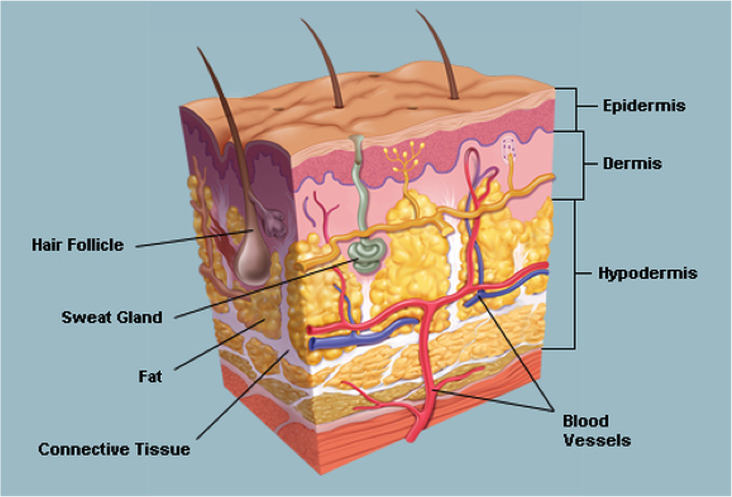Why is skin a challenging organ to regenerate?
When you think of skin, you probably aren’t thinking of the whole picture.
Skin isn’t just a solid barrier between the inside and outside of the body. It is the body’s largest organ, comprised of three layers that contain glands, hair follicles, connective tissue, neurons and fat.
The outermost layer is called the epidermis. It functions primarily as a waterproof barrier, protecting the inside of the body from pathogens and other potentially dangerous things in the environment. It is mostly made up of epithelial cells, which are constantly renewed as more are made and the outer ones are shed. The epidermis also contains melanocyte cells that produce melanin, the pigment that colours our skin. The middle layer is the dermis, where hair follicles and sweat glands reside. It is composed of robust connective tissues that give skin its smooth appearance and flexible structure, as well as sebaceous glands that secrete sebum, a substance that helps to waterproof the outer layer. The innermost layer is the hypodermis, made up of more connective tissue and fat for insulation. It contains blood vessels for circulation and nutrition of the skin tissues. There are nerves that permeate through the hypodermis into the dermis that enable us to sense pressure, pain, and temperature.

All of these components are able to assemble correctly in developing embryos, but after we’re born, we lose the ability to fully repair parts of our own body, including skin.
When human skin is damaged, only some is able to regenerate itself. If the wound is too large or too deep, full function won’t be restored- we can’t regrow glands or nerves, so although a barrier of epidermis will spread across the wound, the sensations of touch and pain won’t return. Other functions, such as sweating and hair growth, will also be lost permanently.
The loss of sensation and sweating can have implications on both physical and  psychological health. If you lean against something hot or sharp, the pain that you feel tells you to move before you damage your skin further; without it, we could do serious harm to our own bodies without noticing. Sweat and hair have important roles in regulating the temperature of our bodies (thermoregulation). While small wounds won’t have a significant effect on the body, large areas lacking proper thermoregulation could cause complications for other functions of the body.
psychological health. If you lean against something hot or sharp, the pain that you feel tells you to move before you damage your skin further; without it, we could do serious harm to our own bodies without noticing. Sweat and hair have important roles in regulating the temperature of our bodies (thermoregulation). While small wounds won’t have a significant effect on the body, large areas lacking proper thermoregulation could cause complications for other functions of the body.
But why can’t we regrow all the parts of our skin?
Formation of all the components of skin requires signals to be sent to the surrounding tissues, informing the body of the need for each type of cell. After injury, regeneration would require messages to the body informing it of an injury, its location and its extent, and the ability of the body to respond correctly.
Scientists don’t know exactly why we can’t do this- there are examples in the animal kingdom of regrowth, not only of skin, but also of entire limbs, such as the Egyptian Spiny Mouse and the Axolotl. There are also limited examples of human regrowth- young children who lose parts of their fingers can sometimes grow them back, but only if the cut leaves behind the nail bed. This has led scientists to search the nail bed for a population of cells that are able to turn into other types of cells. These are known as stem cells, and they could hold the key to regenerative medicine.
Stem cells are a sort of ‘template’ cell that can differentiate into other cell types, so if scientists could find and push stem cells to differentiate as they want, it might be possible to generate every cell type in the body. The problem is that before they differentiate, stem cells look identical to other cells, and currently can’t be identified before they divide and differentiate.
When an embryo is first created, all of its cells are stem cells, and it develops into an organism comprised of many cell and tissue types. Their fate depends on their environment, both their surrounding cells and the specific features of the microenvironment in their location, called the stem cell niche. Stem cells receive various factors that influence their gene expression, called transcription factors, which define how they develop. Throughout embryonic development, the complex mix of environments interacts to form a whole organism with every necessary cell type.
Developing embryos are also somewhat resistant to injury. This lends support to the idea that stem cells are the key to repairing the body. As we grow, however, our reserve of stem cells decreases. Scientists are working constantly to discover where they still exist in the adult body, and how, once they’re found, what factors to use to manipulate their growth and differentiation to heal injury or cure diseases.
What next?
In skin regeneration specifically, scientists are working to use skin grafts with the right amount and type of tissue, hoping that it contains the chemical factors necessary to successfully regrow damaged tissue. Stem cell therapies are constantly being researched for use in medicine, but the days of human limb regrowth or perfect healing are still the distant future.
Kate Malone Image 2: http://www.picgifs.com/clip-art/sweating/clip-art-sweating-328953-694293/